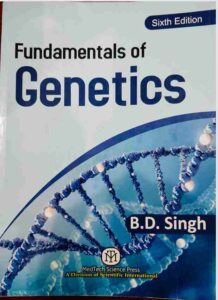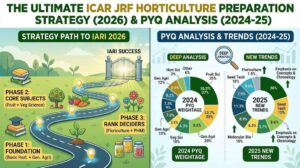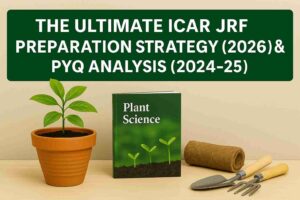BSc Agriculture 6th Semester Hindi Notes PDF
Looking for BSc Agriculture 6th Semester Hindi Notes PDF? You’ll find here subject-wise, exam-focused notes based on the updated 6th Dean Committee syllabus. Perfect for Hindi medium students preparing for their final semester and agri job exams.
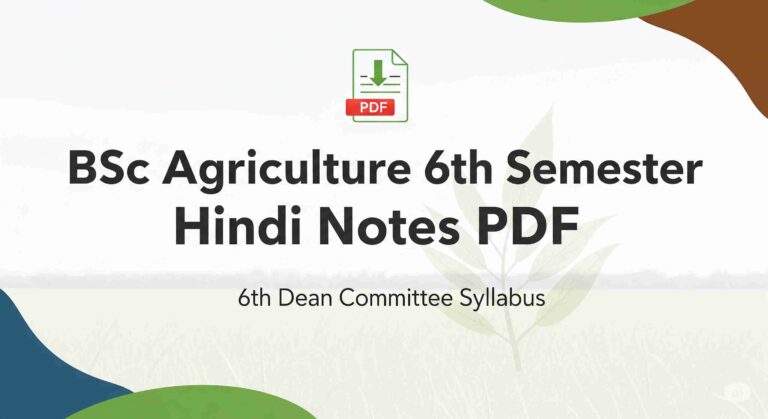
Bsc agriculture 6th semester syllabus (6th dean committee)
6th semester subjects names (6th dean committee)
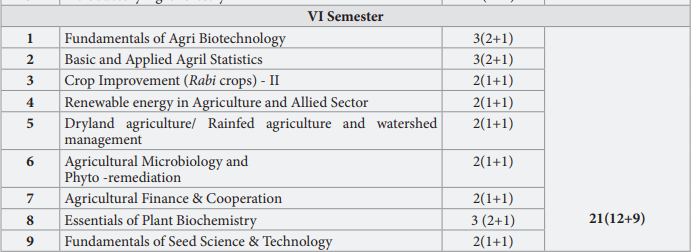
Download BSc Agriculture 6th Semester Hindi Notes PDF Subjects Wish
Fundamentals of Agri Biotechnology 3(2+1)
Basic and Applied Agril Statistics 3(2+1)
Crop Improvement (Rabi crops) - II 2(1+1)
Renewable energy in Agriculture and Allied Sector 2(1+1)
Dryland agriculture/ Rainfed agriculture and watershed management 2(1+1)
Agricultural Microbiology and Phyto -remediation 2(1+1)
Agricultural Finance & Cooperation 2(1+1)
Essentials of Plant Biochemistry 3 (2+1)
Fundamentals of Seed Science & Technology 2(1+1)
Topics covered in the BSc Agriculture 6th Semester Hindi Notes PDF
1. Fundamental of seed science notes topics
- Seed Technology (Definition, Objectives, Importance)
- Seed Deterioration (Causes, Control of seed quality)
- Maintenance of Genetic Purity (Factors and Farm operations affecting it)
- Seed Quality (Definition, Characteristics)
- Different Classes of Seed (Nucleus, Breeder, Foundation, Certified, Truthful, Sub-standard seed)
- Seed Certification (Definition, Phase/Progress in India, Procedure, Field Inspection)
- Seed Act (1966) (Establishment, Functions of Central Seed Committee, Seed Testing Laboratories)
- Powers of Seed Inspectors (Sampling, Stopping sale, Seizing documents, Price determination)
- Offences and Penalties related to Seed Act
- Seed Control Order (1983) (Licensing, Price display, Receipt, Distribution power, Appointment of Inspector)
- Varietal Identification (Grow-Out Test, Electrophoresis)
- World Trade Organization (WTO) (Headquarters, Establishment, Patenting)
- Plant Breeders’ Rights (PBR) (Definition, Benefits, Harms)
- Intellectual Property Right (IPR) (Definition, Protection methods, Patenting)
- Seed Processing (Definition, Importance, Steps, Principle, Drying, Advantage of Drying, Principle of Drying, Methods of Drying)
- Seed Testing for Quality Assessment (Definition, Importance, Seed Sampling, Equipment used)
- Seed Treatment (Definition, Importance, Methods)
- Seed Packing (Importance, Methods of Bagging, Labeling, Types of bags)
- Seed Storage (Definition, Methods, Principles, Factors affecting longevity, Measures of pest and disease control)
- Seed Marketing (Definition, Marketing steps, Marketing organization, Sales promotion activities, Factors affecting seed marketing)
2. Renewable energy in agriculture notes topics
- Introduction (Energy Sources, Primary and Secondary Energy Sources)
- Wind Energy (Formation of Wind, Thermal Effect, Dynamic Effect, Local Effect)
- Concept of Wind Energy
- Classification of Wind Mills (Horizontal Axis Wind Machine, Vertical Axis Wind Machine, Classification by Size, Output Power, Rotation Speed, Utility)
- Horizontal Axis Wind Machine (Using Two Aerodynamic Blades, Propeller Type Using Single Blade, Multibladed-Type, Dutch Type, Sail Type Wind Mill)
- Vertical Axis Wind Machines (Savonius Rotor, Darrius Machines, Magnus Effect)
- Advantages and Disadvantages of Savonius Rotor System
- Advantages and Disadvantages of Darrius Machine
- Application of Wind Mills (Pumping Applications, Direct Heat Applications, Electric Generation Applications)
- Advantages and Disadvantages of Wind Energy
- Mean Wind Speed (Definition, Mathematical Calculation)
- Power Coefficient
- Mechanical Power
- Speed Ratio or Tip Speed Ratio
- Local Speed Ratio and Mean Speed Ratio (Relation between Local Speed Ratio and Tip Speed Ratio)
- Torque of Wind
- Torque Coefficient of Wind
- Basic Components of Simple Wind Mill (Rotor, Nacelle, Motor and Control, Drive Mechanism, Braking System, Wind Vane, Anemometer, Tower, Controller, Electricity Generator)
- Some Basic Definitions (Anemometer, Cut-in Velocity, Cut-out Velocity, Low Wind, High Wind, Cut Wind, Axis Height, Turbine Generator, Windrose)
- Construction and Working of Wind Mill
- Merits and Demerits of Vertical Axis Machine and Horizontal Axis Wind Mills
- Wind Map of India (Wind Power Densities Distribution in the State of India)
- Site Selection Consideration (High Annual Average Wind Velocity, Availability of Anemometry Data, Availability of v-t Curve, Wind Structure at the Proposed Site, Altitude of the Proposed Site)
- Solar Energy (Introduction, Major Uses, Characteristics of the Sun, Total Radiation)
- Solar Collector (Flat Plate Solar Collector, Liquid Flat Plate Collector, Components of Liquid Flat Plate Collector)
- Concentrating Collectors (Aperture, Concentration Ratio, Acceptance Angle, Classification of Concentrating Collectors)
- Types of Concentrating Collectors (Plane Reflectors Collector, Cylindrical Parabolic Collector, Compound Parabolic Collector, Point Focusing or Paraboloid Collector, Fresnel Lens Collector)
- Advantages and Disadvantages of Concentration Collectors over Flat Plate Type Collectors
- Necessity of Orientation System in Focusing Type Concentrating Collectors
- Sun Tracking Systems (Manual System, Mechanised System – Sun Seeking System, Programmed System)
- Performance of Concentrating Collector
- Solar Water Heater (Collector coupled to storage tank, Collector-cum-storage system, Natural Convection System/Thermosyphon System, Pump Driven Water Heater)
- Construction and Working of Flat Plate Type Solar Cooker with Reflector
3. Agriculture finance and cooperation notes topics
- Agricultural Finance
- Credit
- Sources of agricultural finance
- An introduction to higher financing institutions
- Recent development in Agricultural Credit
- Preparation and analysis of financial statements
- Basic guidelines for preparation of project reports
- Agricultural Cooperation
- Crop Insurance
- Successful cooperative systems
- Reference Books
- Problems of Rural & Agril. Indebtedness
- Classification of Credit Institution in Agriculture
- Principles of Agricultural Credit
- 5 CS OF CREDIT
- 7 Ps of farm credit / Principles of farm finance
- Lead Bank Scheme
- Kisan Credit Card
- Tools of Financial Analysis (Budgeting: Partial, Enterprise, Complete, Balance Sheet, Income Statement)
- Recent Trends in Agricultural Credit
- Self Help Groups (SHGs)
- The Gramin Bank Model
- Microfinance
- Scale of Finance
- Single Window System
- Deposit Insurance and Credit Guarantee Corporation of India (DICGC)
4. Agriculture microbiology notes topics
- सूक्ष्मजीवों का संसार (World of Microorganisms) – This includes an introduction to microorganisms, their classification, and the different branches of microbiology (Bacteriology, Protozoology, Mycology, Virology, Phycology, Medical Microbiology, Agricultural Microbiology, Dairy Microbiology, Plant Pathological Microbiology, Industrial Microbiology).
- सूक्ष्म जीवों का प्रकृति में वितरण (Distribution of Microorganisms in Nature)
- सूक्ष्म जैविकी का इतिहास (History of Microbiology)
- प्रोकैरियोटा एवं यूकैरियोटा (Prokaryota and Eukaryota) – This covers the definition, characteristics, and differences between prokaryotic and eukaryotic cells.
- बेक्टीरिया (Bacteria) – This section details the characteristics, structure, and components of bacteria.
- नील हरित शैवाल (Blue Green Algae / Cyanobacteria)
- रसायन संश्लेषी जीवाणु (Chemosynthetic Bacteria) – Includes different types like Hydrogen Bacteria, Sulphur Bacteria, Iron Bacteria, Methane Bacteria, Manganese Bacteria, Nitrifying Bacteria (Nitrosomonas, Nitrobacter), and Denitrifying Bacteria.
- प्रकाश संश्लेषी जीवाणु (Photosynthetic or Photoautotrophic Bacteria) – Includes Purple Sulphur bacteria and Purple Non-sulphur bacteria.
- जीवाणुओं में जनन (Reproduction in Bacteria) – Covers Conjugation, Transformation, and Transduction.
- प्लाजमिड्स (Plasmids) – Definition, types (Conjugative and Non-conjugative plasmids), and structure.
5. Biotechnology notes topics
- Carbohydrates (कार्बोहाइड्रेट): This section defines carbohydrates, their elemental composition, and their classification into monosaccharides, oligosaccharides, and polysaccharides (including sugar and non-sugar types). It also discusses the properties of monosaccharides and the structure of disaccharides (sucrose) and polysaccharides (cellulose).
- Lipids (लिपिड): This section defines lipids, their solubility properties, and their classification based on chemical organization (simple, compound, and derived lipids). It also highlights the importance of lipids and provides a detailed classification and properties of fatty acids.
- Proteins (प्रोटीन): This section defines proteins, their chemical composition, and their significance (physiological, biological, and industrial importance). It also covers the classification of proteins based on composition and solubility (simple, conjugated, and derived proteins) and based on their shape (fibrous and globular proteins) and function. The structure of proteins, including primary, secondary, tertiary, and quaternary structures, is also explained.
- Enzymes (एंजाइम): This section defines enzymes, their properties (solubility, molecular weight, precipitation, specificity, catalytic nature, heat sensitivity, instability, reversibility, activators, and inhibitors). It also details the classification of enzymes into six major classes (Oxidoreductases, Transferases, Hydrolases, Lyases, Isomerases, and Ligases) and explains the mechanism of enzyme action, including the Enzyme-Substrate Complex theory and factors affecting enzyme activity.
- Nucleic Acid (न्यूक्लिक एसिड): This section defines nucleic acids, their importance (storage and transfer of genetic information, protein synthesis control), and the structure of nucleotides, including the components (nitrogenous base, pentose sugar, phosphoric acid). It also differentiates between the nucleotides found in RNA and DNA.
Download other semester notes PDF in Hindi.
BSc Ag. Semseter Name | Hindi Notes PDFs |
1st semester | |
2nd semester | |
3rd semester | |
4th semester | |
5th semester | |
6th semester |
Download other semester notes PDF in English
BSc Ag. Semseter Name | English Notes PDFs |
1st semester | |
2nd semester | |
3rd semester | |
4th semester | |
5th semester | |
6th semester |
Join our community
Click to Join Our Free WhatsApp Group and YouTube for Agriculture Updates!
Get daily updates, free study material, and the latest schemes, and connect with other agriculture students and farmers.
After bsc agriculture jobs syllabus
Latest Syllabus | Download Here |
IBPS Agriculture Filed Officer | |
NABARD GRADE A | |
Food Corporation of India (FCI) | |
RAEO | |
RHEO | |
Food Inspector | |
IFFCO AGT | |
MP PAT | |
UPSSSC AGTA |
Latest post
Fundamentals of Genetics by B.D. Singh Book PDF: A Comprehensive Review & Why It’s a Must-Have for Agri Students
Let’s be honest for a second—when most of us join...
Read MoreBest Books for ICAR JRF Horticulture 2026: The Topper’s Booklist (Updated)
Table of Contents Are you still dreaming of IARI relying...
Read MoreBest Books for ICAR JRF Plant Science 2026: The Ultimate Booklist (Updated)
Table of Contents Are you still planning to crack JRF...
Read MoreThe Ultimate ICAR JRF Agronomy Preparation Strategy (2026) & PYQ Analysis (2024-25)
Table of Contents Do you dream of walking into the...
Read MoreReferences
ICAR – Indian Council of Agricultural Research
https://icar.org.inBSMA Portal – ICAR Education Division
https://bsma.icar.gov.inAgriIndia.info
https://agriindia.infoAgriLearner.com
https://agrilearner.comAgriExam.com
https://agriexam.com

